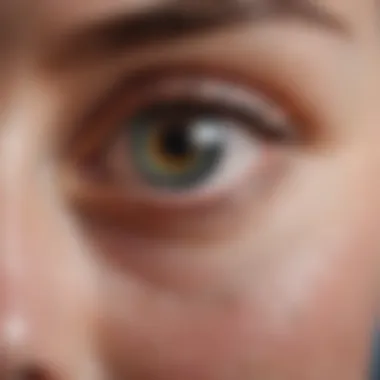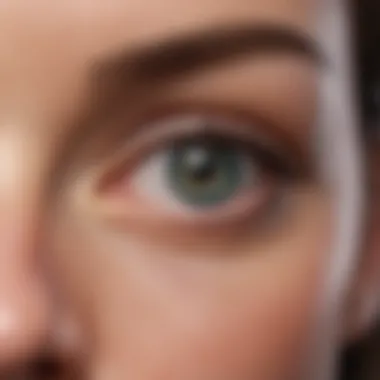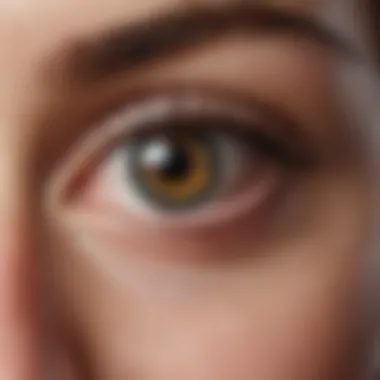Expert Tips for Safely Removing a Stuck Contact Lens


Intro
Experiencing a contact lens trapped in the eye can be distressing. This situation can occur for several reasons, often stemming from improper lens application or environmental factors. Addressing this issue is paramount to maintaining ocular health.
Contact lenses can occasionally adhere to the eye due to lack of moisture or changes in the environment. Individuals who wear lenses must be aware of the best practices to remove a stubborn lens. This article will outline effective techniques and also discuss how to avoid such predicaments in the future.
Key Takeaways
- Common Causes: Understanding why a contact lens might get stuck is crucial. Dryness, improper lens fit, and extended wear can contribute to this problem.
- Safe Removal Techniques: Knowing the correct methods for removal minimizes the risk of injury to the eye.
- When to Seek Professional Help: Recognizing the signs that indicate a need for expert intervention ensures that complications do not arise.
In-Depth Analysis
Common Causes of Stuck Contact Lenses
There are multiple factors that can lead to a lens becoming lodged in the eye. Here are some key causes:
- Dry Eye: Insufficient moisture can cause the lens to adhere to the cornea.
- Extended Wear: Wearing lenses longer than recommended increases the likelihood of complications.
- Incorrect Fit: Lenses not designed for the individual's eye shape may lead to discomfort and sticking.
Techniques for Safe Removal
- Stay Calm: Panicking can make the situation worse.
- Wash Hands: Clean your hands thoroughly with soap and water. This reduces the risk of infection.
- Use Eye Drops: Lubricating eye drops can help loosen the lens.
- Blink and Look Around: Sometimes, blinking repeatedly or looking in different directions can shift the lens back into place.
- Position Your Eye: Tilt your head, pulling the eyelid away from the eye and look upward.
- Gently Pinch the Lens: If it is visible, carefully pinch the lens with your fingers to remove it.
"Practicing good lens hygiene can prevent many complications."
When to Seek Professional Help
In some cases, the lens may not budge. It’s essential to monitor for any signs of complications:
- Pain or Discomfort: Persistent pain necessitates consulting a professional.
- Redness or Swelling: These could indicate irritation or infection.
- Vision Changes: Any sudden change in vision should be addressed immediately.
Culmination
Understanding how to effectively remove a contact stuck in the eye is essential for all lens wearers. By knowing the reasons for lens adhesion and practicing proper hygiene, individuals can better protect their eyesight. In case of persistent issues, seeking professional assistance is a prudent choice. Maintaining eye health is fundamental, not just for comfort, but for overall well-being.
Foreword
The ability to safely remove a contact lens that has become stuck in the eye is essential knowledge for those who use them. This situation, while often not severe, can provoke anxiety and discomfort. Understanding how to deal with a stuck lens is crucial to ensure eye health and prevent long-term complications.
Many individuals wear contact lenses for convenience, aesthetic preference, or due to vision issues. However, the risks are inherent to this practice. One such risk involves the lens becoming lodged in the eye, resulting from various causes such as dry eyes or improper application. It's important to recognize the potential challenges and develop a clear strategy to manage them.
This section emphasizes the significance of being prepared and educated on the correct procedures for contact lens removal. Knowing how to respond appropriately can reduce panic and provide relief quickly. Also, timely action can alleviate potential irritation or damage to the eye.
In this article, we delve deeper into the causes, several safe removal techniques, and aftercare practices. You will learn the necessary steps for both handling a stuck contact lens and making informed decisions for your health. By prioritizing safe methods, we encourage readers to be proactive in their eye care, thus fostering a culture of awareness and responsibility in lens usage.
Understanding Contact Lenses
A solid understanding of contact lenses is essential for anyone who uses them or is considering their use. Contact lenses are medical devices that sit directly on the cornea of the eye. They offer an alternative to glasses, providing improved vision without the bulk or weight associated with eyeglasses. Moreover, they can enhance peripheral vision and allow for a more active lifestyle.
Several factors should be considered when discussing contact lenses, such as comfort, fit, and eye health. The proper lens selection can prevent many complications associated with use. If lenses are not suited to the wearer's eye condition, discomfort can occur. Additionally, knowing how to care for lenses is crucial in avoiding infections that may arise from poor hygiene practices.
Another key aspect is the adaptability of contact lenses. They are available in various types and designs tailored to different visual and personal needs. This flexibility makes them appealing to a wide array of users.
By comprehending these elements, individuals can make more informed choices about their eye care and the type of lenses that may suit them best. This understanding sets the stage for recognizing the potential challenges, including the risk of getting a lens stuck in the eye.


Types of Contact Lenses
Contact lenses are categorized mainly into two types: soft lenses and rigid gas permeable lenses.
Soft lenses are made of soft, flexible plastics that allow oxygen to pass through to the cornea. They are often recommended for beginners because they are comfortable to wear. Examples of soft lenses include daily disposables, extended wear, and toric lenses for astigmatism. Soft lenses typically adapt well to different eye shapes.
On the other hand, rigid gas permeable lenses provide clearer vision because they maintain their shape while allowing oxygen to reach the eye. These lenses can last longer than soft lenses and are often more durable. However, they may take longer for the user to adapt to. Some individuals prefer these for their vision quality, especially those with specific refractive errors.
Key Differences:
- Comfort: Soft lenses are generally considered more comfortable, especially for new users.
- Vision Quality: Rigid lenses often provide sharper vision for certain conditions.
- Care: Soft lenses may require more frequent replacement and special care solutions than rigid lenses.
Common Issues with Contact Lenses
Even with proper care, many encounter issues with contact lenses. Understanding these problems can aid in both prevention and management.
- Dry Eyes: Users may experience dryness, making the lens feel uncomfortable. This can occur due to extended wear or environmental factors like air conditioning.
- Infections: Poor hygiene can lead to serious conditions such as keratitis, an infection of the cornea. It’s crucial to follow the recommended cleaning and storage practices.
- Discomfort: Lenses may feel irritating if they are damaged or not fitted properly. Users should consult with an eye care professional if discomfort persists.
- Lens Dislocation: Occasionally, a lens may shift out of position, becoming difficult to remove. Knowing how to respond in this situation is vital.
Recognizing these common issues enhances the overall user experience and preserves eye health.
Causes of a Stuck Contact Lens
Understanding the causes of a stuck contact lens is crucial for both prevention and effective removal. A stuck lens can lead to discomfort and potential damage to the eye if not addressed properly. Moreover, knowing why a lens might get stuck aids in developing strategies to avoid similar issues in the future. Addressing these causes emphasizes the significance of proper lens care and ensures a more comfortable experience for contact lens wearers. Below are three common culprits that often lead to this predicament.
Dry Eyes
Dry eyes can be a primary factor behind a stuck contact lens. When the eyes lack sufficient moisture, the lens may adhere to the surface of the eyeball. A lack of lubrication reduces the regular blinks from moving the lens around, causing it to grip the eye. This scenario is particularly common in environments with air conditioning, prolonged screen time, or exposure to wind.
A moisture imbalance increases irritation, making it painful to remove the lens. Regular use of artificial tears can help maintain comfort and prevent dryness, especially for those who wear lenses frequently. It's advisable to consult with an eye care professional if dry eye symptoms persist, as they may suggest tailored treatments or lens types that may suit your needs better.
Incorrect Lens Application
An incorrect lens application can also contribute to a stuck lens. Misplacing the lens during insertion is a common error, often resulting in the lens sitting inappropriately on the eye. This situation can lead to the lens shifting out of its ideal position, creating a sensation of it being lodged.
Additionally, handling the lens improperly can make it hard to position correctly. For instance, failing to ensure lenses are not inside out or not adequately prepped with solution can lead to complications. It is essential to follow guidelines meticulously during the application process to avoid such mistakes.
Lens Dislocation
Lens dislocation is a more severe cause of a stuck contact. Here, the lens shifts from its designated spot on the cornea to a less stable area, such as behind the eyelid. This movement can occur if the lens is worn for too long, or due to sudden eye movements. A dislocated lens can feel like it is stuck, even if it is not directly lodged against the eyeball.
When a lens dislocates, it becomes essential to proceed with caution. Attempting to remove a dislocated lens without proper technique may cause further issues or damage. Therefore, understanding how dislocation occurs can inform wearers about the importance of adhering to replacement schedules and checking fit.
It is important to highlight that knowing these potential causes helps in better management and in being proactive about one's eye health. Regular consultations with eye care professionals can also offer personalized insights.
Safety Precautions
When dealing with a contact lens that is stuck in the eye, safety precautions are essential. These practices not only help in preventing further complications but also ensure that the removal process is done safely and effectively. Understanding when it is appropriate to attempt removal and recognizing situations that warrant professional help can make a significant difference for your eye health.
When to Avoid Self-Removal
There are specific situations where trying to remove a stuck contact lens on your own may not be advisable. If you notice persistent pain, redness, or swelling around the eye, these may be signs that you should seek help from a medical professional.
Additionally, if your vision becomes blurred or you see halos around lights, this indicates a potential complication that could be serious. In cases of excessive tearing or discharge, it's best to avoid self-removal as bacteria might cause an infection.
It’s worth noting that certain lenses, particularly those that are older or more fragile, can tear easily. If a lens rips during removal attempts, fragments can potentially remain in the eye and lead to further issues.
Signs of a Medical Emergency


Certain symptoms indicate that an immediate medical consultation is necessary. If you experience severe pain that feels more intense than typical discomfort from a lens, this could signal an urgent issue like a corneal abrasion.
Other important signs to watch for include:
- Vision Changes: Noticeable shifts in vision, such as blurriness or distortion, require attention.
- Extreme Redness: A highly inflamed eye may indicate infection or other eye disorders, demanding prompt evaluation.
- Ongoing Discomfort: If discomfort persists despite attempts to remove the lens, you should consult a professional.
In summary, while it is crucial to act promptly when a contact lens is stuck, knowing when to seek help can prevent complications. Prioritizing safety ensures that your eyes stay healthy.
Steps for Removing a Stuck Contact Lens
Removing a contact lens that is stuck in the eye can be a nerve-wracking experience. It is essential to approach this situation calmly and methodically. Each step contributes significantly to increasing the chance of successfully removing the lens without causing any harm or irritation to the eye. This systematic approach not only helps in lens removal but also enhances the overall health of the eyes. Understanding each phase ensures that the process is safe and effective.
Initial Assessment
The first step in this process is to assess the situation accurately. Determine whether the lens is indeed stuck, or if it has simply shifted out of sight. Look in the mirror and observe if the lens is visible in the white part of your eye or hidden under the eyelid. If it is not visible, carefully examine for any discomfort, redness, or tearing, which could indicate an issue. Recognizing the signs early helps maintain a proper course of action during removal.
Hand Washing and Preparation
Before attempting to remove the stuck lens, it is crucial to wash your hands thoroughly. Use warm water and mild soap to cleanse your hands, focusing on the fingernails and between the fingers. Dry them with a lint-free towel. This step minimizes the risk of bacteria entering the eye, which is essential when dealing with any ocular manipulation. Proper hygiene is paramount to ensure eye health during this process.
Moistening the Eye
To aid in the removal of a stuck contact lens, moisten the eye. Using a rewetting drop specifically designed for contact lenses can help in easing the lens off the eye surface. This moisture reduces friction between the lens and the cornea, making it easier to remove the lens safely. Gently pulling the lower eyelid down while applying the drops can provide better coverage across the eye.
Blinking Techniques
After moistening the eye, try engaging in gentle blinking. Natural blinking can help shift the position of the lens, allowing it to move if it is not entirely stuck. Blink a few times at a regular pace, ensuring you do not rush this process. If the lens remains unresponsive, you can repeat the moistening step and try again. This technique is non-invasive and often helps many individuals.
Using Eye Drops or Saline Solution
If the lens still does not budge, utilizing eye drops or a saline solution is an effective next step. These solutions lubricate the eye and lens, reducing any potential clinging. Applying them directly onto the surface of the eye can create a cushioning effect, facilitating lens movement. If possible, consider using preservative-free options to avoid irritation. Follow the manufacturer’s instructions for proper usage.
Manual Removal Techniques
If the previous methods are not successful, manual handling of the lens might be necessary. This is usually done with care to avoid damaging the delicate eye surface.
Pinching Method
The pinching method involves using the thumb and index finger to pinch the lens gently. This technique can be effective if performed correctly. The key characteristic of the pinching method is that it allows for direct contact with the lens while offering a greater feel for its position. It is a popular choice among experienced contact lens users. However, care must be taken to avoid pinching the eyelid or applying too much pressure, which could lead to damage or irritation. Always ensure your hands are clean before attempting this method, and slow, calculated movements are preferred.
Using a Suction Cup or Tool
Alternatively, a suction cup or specialized tool can be used for removal. These tools are designed to attach to the lens and gently extract it from the eye. A key aspect of this approach is the precision required in using the tool properly. Many people find this option beneficial because it minimizes the need for direct contact with the eye. Nonetheless, it's important to be cautious. Improper use of the tool can cause harm. Ensure that any tool used is clean and intended for this specific purpose.
Ultimately, it is crucial to prioritize safety and eye health. If you experience significant discomfort or are unable to remove the lens after several attempts, consult an eye care professional promptly.
Following these steps methodically will enhance the likelihood of a successful contact lens removal, ensuring your eye remains unharmed.
Aftercare Post-Removal
After successfully removing a stuck contact lens, properly addressing aftercare is crucial. This stage emphasizes eye health and recovery, reducing the risk of complications. Poor aftercare may lead to irritation. Thus, an informed follow-up is essential to ensure the eyes recover well.
Inspecting for Irritation
Once the lens is removed, take a moment to examine the eye closely. Look for signs of redness, swelling, or unusual discomfort. These symptoms could indicate irritation or an allergic reaction to the lens or the removals process. Gently pull down the lower lid and examine the area underneath. If discomfort persists beyond a short period, or if you notice any abnormal symptoms, it is wise to seek professional consultation.


Rehydrating the Eyes
After the discomfort of having a lens stuck, it is important to rehydrate your eyes. Use preservative-free artificial tears to provide moisture. These drops soothe the eyes and promote healing of any minor abrasions. A few drops should be applied several times throughout the day. Avoid using lens solution or tap water, as these may cause further irritation or increase the risk of infection.
When to Consult an Eye Care Professional
Should your eyes not respond to rehydration within a few hours or if irritation continues, it is critical to consult an eye care professional. Indicators for this include severe pain, persistent redness, or visually impaired symptoms like blurred vision. Health experts can better assess if there is damage or infection requiring treatment. Timely intervention can help in avoidng potential complications.
The End
In the realm of eye care, understanding how to effectively remove a stuck contact lens is vital. Many individuals wear contact lenses for comfort, convenience, and to enhance vision without the barrier of glasses. However, despite their advantages, complications can arise — particularly when a lens becomes lodged in the eye. This article has presented a structured approach for addressing such situations, underlining both safety and efficacy.
The key benefits of knowing how to remove a stuck lens include not just immediate relief from discomfort, but also the prevention of potential complications. Unresolved incidents can lead to eye infections or further dislocations, hazards that can compromise vision. Therefore, having a comprehensive understanding of removal techniques empowers individuals to act confidently and efficiently upon realizing a lens is not in the proper position.
An essential consideration is also the aftercare discussed in the earlier sections. Inspecting for irritation, rehydrating eyes, and determining when to seek help from an eye care professional are all critical steps in safeguarding ocular health post-removal. Each step taken after a successful lens extraction contributes to long-term eye health and comfort.
Ultimately, awareness and preparedness can transform a potentially alarming experience into a manageable one. Familiarity with the techniques outlined in this guide not only equips individuals with the tools necessary for self-care but also encourages proactive behavior regarding eye health. Keeping a composed mindset and taking informed actions should remain at the forefront when dealing with contact lens complications.
"Empowering individuals with knowledge is the first step in preventing unnecessary complications from contact lens mishaps."
By adhering to best practices, one fosters a smoother interaction with contact lenses, enhancing their overall experience while minimizing the risks associated with improper usage. In the end, this reduces not just the incidence of emergency visits to eye care professionals, but also cultivates a culture of informed and health-conscious contact lens use.
Relevant Articles on Eye Care
Informative articles offer essential insights that can aid in increasing awareness regarding proper eye care. Topics within these articles may include guidance on eye hygiene, discussions on various types of contact lenses, and tips for maintaining healthy vision. Reliable sources provide articles that encapsulate the latest research, best practices, and a variety of experiences related to eye care. Reading these resources may enlighten users on common conditions that affect eye health as well as preventative measures they can take.
Some recommended articles may cover subjects like:
- The importance of regular eye exams
- Effects of digital screen time on eye health
- Signs of common eye issues and when to see a doctor
Contact Lens Care Guidelines
Following contact lens care guidelines is paramount for maintaining the health of both the eyes and the lenses themselves. Guidelines typically include safe practices for insertion and removal, tips for cleaning the lenses, and signs that indicate a lens should be replaced. Knowledge of these practices can help users avoid complications such as infections or lens damage that directly affect ocular comfort and health.
Essential components of these guidelines often focus on:
- The necessity of always washing hands before handling lenses.
- Recommendations for storage solutions like contact lens cases.
- Information about expiration dates of lens products.
- Urging users to consult eye care professionals regularly for their specific needs.
By familiarizing themselves with these guidelines, users will enhance their understanding of how to properly care for their contact lenses. This fosters not only comfort but also long-term eye health.
Common Questionss About Contact Lens Removal
In the realm of eye care, understanding the nuances of contact lens removal is crucial. Questions often arise when individuals face challenges, especially when a lens becomes lodged in the eye. This section provides clarity and guidance through some frequently asked questions, allowing readers to gain insight into safe practices regarding contact lenses.
Addressing FAQs is an important aspect of any comprehensive guide. They serve to inform and reassure readers, ensuring they feel confident in managing situations related to their eye health. By answering common queries, readers can preemptively address concerns. This not only enhances their understanding but also encourages better practices in contact lens maintenance and removal.
What to do if the lens is still stuck?
If a contact lens remains stuck in the eye, it is essential to remain calm and avoid panic. First, assess the situation carefully. Ensure that the lens is indeed lodged and not simply misplaced. If you have already attempted removal with no success, consider the following steps:
- Stay hydrated: Drinking water can help by keeping the eyes lubricated to some extent.
- Use eye drops: A few drops of sterile saline solution or artificial tears can provide relief. This may help in loosening the lens, making removal easier.
- Avoid forceful rubbing: Rubbing the eye can lead to injury. Instead, try blinking gently to see if the lens moves away from its stuck position.
- Re-evaluate: Look carefully in a well-lit area. Sometimes, the lens can be found resting on the white part of the eye.
If these approaches do not yield results, it might be time to contact a healthcare professional. Ignoring the situation can lead to discomfort or possible damage to the eye. Seek assistance when necessary, especially if irritation persists.
Can sleep with a stuck contact lens?
Sleeping with a stuck contact lens can lead to various complications, making it advisable to avoid this situation. The potential risks include:
- Infection: Wearing the lens overnight can increase the chances of developing an eye infection due to reduced oxygen flow and potential debris accumulation.
- Corneal damage: Extended wear can lead to scratching or other injuries to the cornea, which may result in severe consequences if left unattended.
- Inflammation: The eye may become inflamed, leading to discomfort and vision issues.
If you find yourself in a situation where the lens is stuck, it is best to try to remove it as soon as possible. If removal is not possible and sleep is unavoidable, consult with a healthcare professional promptly upon waking. Prevention is always better than dealing with the aftermath of complications.







